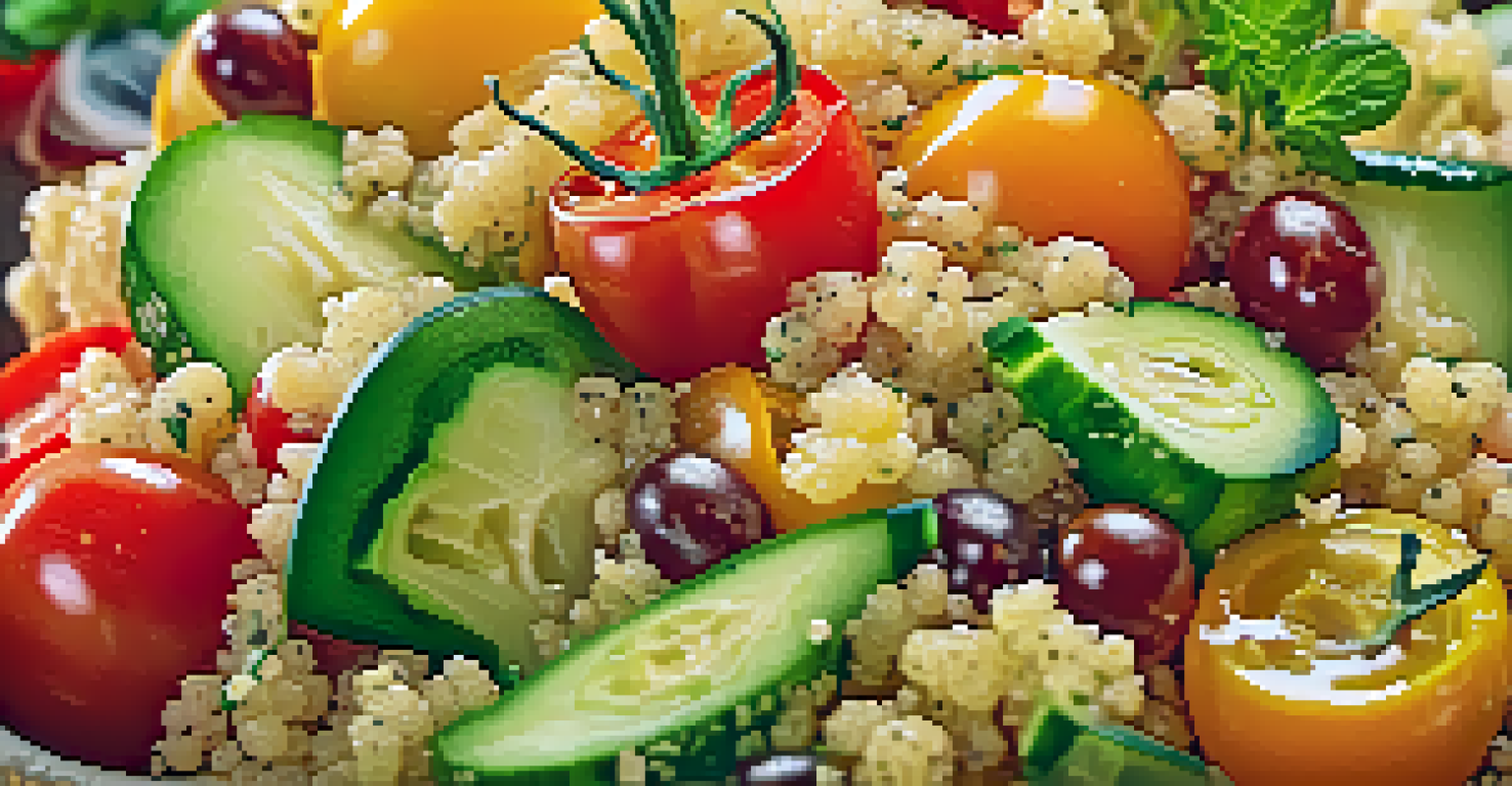Mindful Eating Tips for Enjoying Vegan Food and Wellness

Understanding Mindful Eating: A Vegan Perspective
Mindful eating is all about being present during meals, paying attention to the flavors, textures, and aromas of your food. For those embracing a vegan lifestyle, it’s an opportunity to connect deeply with the bounty of plant-based ingredients available. Think of it as savoring each bite like a fine wine, where you take your time to appreciate the nuances of each flavor.
Mindful eating is about being present with your food, enjoying the experience of each bite, and connecting with your body’s natural hunger cues.
When you approach vegan food mindfully, you not only enjoy your meals more but also cultivate a deeper appreciation for the ingredients. This practice can help you become more aware of how different foods make you feel, both physically and emotionally. By focusing on the experience rather than simply feeding your hunger, you create a positive relationship with food.
As you start this journey, remember that mindfulness is a skill that develops over time. It’s not about perfection; it’s about progress and finding joy in your meals. So, let’s explore some effective tips to integrate mindful eating into your vegan diet.
Create a Peaceful Eating Environment
Your eating environment plays a crucial role in how you experience your meals. To practice mindful eating, try to eliminate distractions. This means turning off your phone, stepping away from the computer, and finding a quiet spot where you can focus on your food. Imagine yourself in a serene garden, surrounded by the colors and scents of nature—this is the ambiance you want to cultivate.

Consider setting the table with care, perhaps using a beautiful plate or adding a small vase of flowers. Creating a visually appealing space can enhance your dining experience and make each meal feel special. As you sit down, take a moment to breathe deeply and express gratitude for the food before you.
Mindful Eating Enhances Enjoyment
Practicing mindful eating allows you to fully appreciate the flavors and textures of your vegan meals.
By establishing a peaceful eating environment, you’re more likely to engage your senses fully. This intentionality allows you to enjoy every aspect of your meal, from the first bite to the last, making your vegan food more satisfying.
Savor Each Bite: Chewing and Tasting Mindfully
One of the simplest ways to practice mindful eating is to slow down and savor each bite. Chewing thoroughly not only aids digestion but also enhances your tasting experience. Instead of rushing through your meal, try to chew your food at least 15-20 times before swallowing. This might feel unusual at first, but it allows you to fully appreciate the flavors and textures of your vegan dishes.
Food is not just fuel, it's an experience to be savored and appreciated, a celebration of the wholesome ingredients that nourish us.
As you chew, focus on what you’re tasting. Is the dish creamy, crunchy, spicy, or sweet? Take mental notes of how the different components of your meal come together. For instance, if you’re enjoying a quinoa salad, notice how the nutty quinoa pairs with the crisp vegetables and zesty dressing.
By savoring each bite, you’ll likely find that you feel more satisfied with smaller portions. This can help you avoid overeating and encourage a healthier relationship with food, making your vegan meals more enjoyable overall.
Listen to Your Body’s Hunger Signals
Mindful eating involves tuning into your body’s natural hunger cues. Before diving into a meal, take a moment to assess your hunger level. Are you truly hungry, or are you eating out of habit or boredom? This practice encourages you to differentiate between physical hunger and emotional cravings, allowing for a more balanced approach to eating.
You might consider using a hunger scale from 1 to 10, where 1 means starving and 10 means overly full. Aim to eat when you’re around a 3 or 4, and stop when you feel comfortably satisfied at a 6. This awareness can transform your relationship with food and help you make more intentional choices about what and how much you eat.
Create a Peaceful Eating Space
Establishing a serene environment free from distractions can enhance your dining experience and promote mindfulness.
Listening to your body not only enhances your mindful eating experience but also aligns with the principles of a vegan diet. By responding to your body’s needs, you’ll feel more energized and connected to the food you consume.
Experiment with Plant-Based Ingredients
One of the joys of a vegan diet is the vast array of plant-based ingredients available to explore. Mindful eating encourages you to experiment with new foods and flavors. Instead of sticking to the same meals, challenge yourself to try a new vegetable, grain, or spice each week—a bit like a culinary adventure.
For example, if you usually enjoy spinach, why not try kale or Swiss chard? Each green has its own unique flavor profile and health benefits. Similarly, experimenting with different grains, like farro or quinoa, can add variety to your meals and make them more interesting.
This exploration not only enriches your diet but also makes you more engaged during meal preparation. As you chop, sauté, or steam, take a moment to appreciate the colors and textures of the ingredients. This mindful approach can lead to delightful discoveries and a more satisfying vegan dining experience.
Practice Gratitude for Your Meals
Incorporating gratitude into your meals is a powerful aspect of mindful eating. Before you eat, take a moment to acknowledge where your food comes from, who prepared it, and the time and effort that went into making it. This simple act can transform your meal from a mundane task into a meaningful ritual.
You might even consider keeping a gratitude journal where you jot down what you appreciate about your meals. Perhaps it’s the vibrant colors of your vegetable stir-fry or the comforting aroma of a lentil soup. By reflecting on these aspects, you deepen your connection to your food and cultivate a positive mindset.
Gratitude Deepens Food Connection
Incorporating gratitude into your meals transforms eating from a mundane task into a meaningful ritual.
Practicing gratitude can enhance your overall well-being, making your meals not just about nourishment but also about joy and appreciation. This approach can significantly enrich your vegan dining experience.
Mindful Eating Beyond the Plate
Mindful eating extends beyond just the act of consuming food; it encompasses your entire approach to food and wellness. This means paying attention to how you source your ingredients, opting for seasonal and local produce when possible. By doing so, you not only support your local economy but also enjoy fresher, tastier food.
Additionally, consider how your food choices affect the environment. Adopting a mindful approach to eating can inspire you to make sustainable decisions, such as reducing food waste and choosing plant-based options that have a lower carbon footprint. This holistic perspective creates a deeper connection to your meals.

As you embrace mindful eating in a vegan context, you may find that it enhances your overall wellness. By fostering awareness in all aspects of your food journey, you create a lifestyle that nourishes both your body and the planet.
Conclusion: Embracing the Journey of Mindful Eating
Mindful eating is a beautiful journey that invites you to explore the world of vegan food in a more intentional and satisfying way. By following these tips, you can elevate your meals, deepen your appreciation for plant-based ingredients, and create a healthier relationship with food. Remember, it’s not just about what you eat but also how you experience your meals.
As you practice these mindful eating techniques, be patient with yourself. It’s a learning process that takes time and experimentation. Celebrate small victories, whether it’s successfully slowing down during meals or discovering a new favorite ingredient.
Ultimately, the goal is to enjoy each meal to the fullest, fostering a sense of wellness that nourishes your body, mind, and spirit. So, take a deep breath, savor your next bite, and embrace the journey of mindful eating in your vegan lifestyle.